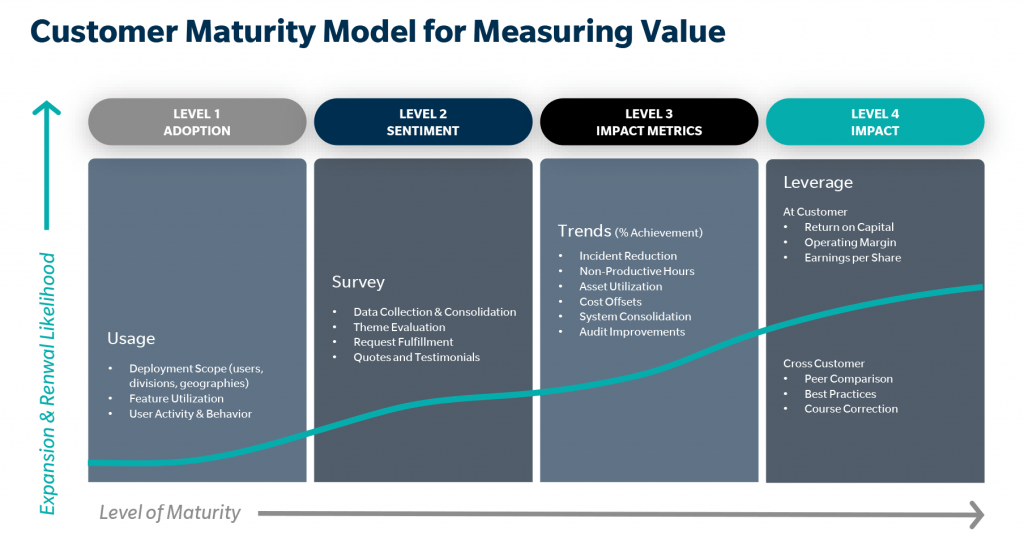Customer Success is the Key to Your Organization’s Value Maturity

At the recent Gainsight Pulse conference, DecisionLink’s Sterling Cottam, Senior Director of Product & Platform Value, introduced the Customer Value Management (CVM) Maturity Model in an eye-opening lightning talk. While more and more companies realize the importance of customer value in the sales stages of their relationships, the impact of CVM at every step of the customer journey is a game-changer for customer success teams and overall net recurring revenue.
CVM is an Essential Customer Success Tool
As the craft of customer success evolves and effective CVM tools become available, value can be more easily integrated into every customer conversation. No matter how good your people skills are in customer success, data shapes how your customers see you. The cold, hard facts of the tangible value you deliver to your customers plays an essential role in their perception of your organization. According to our research, companies can increase net recurring revenue (NRR) by 130% by focusing on value. In fact, one of our customers has found that sharing impact scores with their customers directly increases renewal rates. In situations where impact scores aren’t provided, renewals are less than 100%. When value insights are used, the renewal rate increases to 115%.
The potential for value data to increase your NRR and renewal rates is huge! But, according to Dimensional Research, only 18% of companies can provide the kind of value analysis their customers want to see. For most companies, the ability to express value is spotty because traditional approaches to calculating customer value are extremely manual and hard to scale.
The Phases in the CVM Maturity Model
When you look at the CVM Maturity Model, it’s clear where most companies get stuck —Level 1, Adoption. Clearly, increasing your maturity level is an opportunity to differentiate your company. To make that happen, you have to understand what it means to move up the curve and the tools you will need to make that happen.

Level 1 is all about adoption. By understanding the basics of usage—how many users you have, which features they are taking advantage of, what behaviors you are seeing as a result—you have a sense of reach, but none of impact. Most companies, especially SaaS providers have this information readily accessible. According to Dimensional Research about 59% of companies can access this information. The problem is, it only scratches the surface and does little to move the needle on customer perception.
The shift to Level 2 expands to a more emotional arena. It’s about gauging sentiment, which can be accomplished with surveying tools. Here, we are capturing themes, quotes, testimonials. It is a more qualitative measure of the value provided. While this information can be vital for marketing usage, there is only marginal influence on expansion and renewals. Unfortunately, this is where easy-ish access to value data ends. There is an inherent barrier for most companies between levels 2 and 3.
Transitioning to Level 3 demands a centralized repository for your data. This is where a CVM platform like ValueCloud is essential. More than just metrics, this is about impact metrics. You’ll be looking at trends on things like incident reduction, non-productive hours, asset utilization, cost offsets, system consolidation, audit improvements, whatever is most meaningful to your customer. Determining the right metrics and establishing your baseline for these metrics is an essential part of the early relationship. If it isn’t part of building the value case in the sales process, it should be part of onboarding a new customer. Measurable objectives make all the difference in having meaningful value conversations with your customers at every stage.
As companies move from Level 3 to Level 4, the scale of the impact really begins to take hold. Here we are transitioning from individual measures to overall business impact. This is where the day-to-day accounting of the value you deliver is translated into economic value for the organization as a whole. At an individual company level, we’re looking at return on capital, operating margin, earnings per share, which are all influenced by the impact metrics gathered earlier. In addition, with a tool like ValueCloud, you have the ability to look at metrics cross-customer in peer comparisons and share best practices. At this level of CVM maturity, you can use your value data to create competitive tension amongst customers, which makes discussing opportunities for improvements and expansion that much easier and exciting.
Accelerating Your Maturity
What is evident from the maturity model is that to make a real impact, it is essential to integrate CVM into every step of the customer journey. The more sophisticated your abilities to measure and communicate value to your customer-base, the greater the potential for cross-sell and up-sell.
DecisionLink’s ValueCloud® was developed to make these capabilities more widely accessible, giving marketing and customer success teams the tools they need to bring value-based conversations into every customer interaction.
When you have the data, the emotional tenor of your customer conversations changes. It’s no longer, “I hope they will renew.” Having data to back-up your recommendations shifts the tone from uncertainty to urgency – “My customer needs to expand or they are limiting their business potential.” Crossing into this new world of customer success conversation is powerful.
So, the question is, where are you on this curve? Are you able to scale your value conversations into customer success? Can you share peer best practices? Are you really showing your full value potential? You need to be.
If you’d like to watch Sterling’s Gainsight Pulse lightning talk, watch the video here.

 ValueCloud
ValueCloud
.png?width=118&height=76&name=Rectangle%20(3).png) ValueCloud Ignite
ValueCloud Ignite
.png?width=92&height=92&name=Rectangle%20(4).png) Free Assessment
Free Assessment
.png?width=100&height=100&name=Rectangle%20(5).png) Watch a Demo
Watch a Demo
.png?width=82&height=96&name=Rectangle%20(6).png) Value Calculator
Value Calculator

.png?width=62&height=51&name=Group%2010%20(1).png) Marketing
Marketing
 Sales
Sales
 Customer Success
Customer Success
 Engage Prospects
Engage Prospects
 Win Deals Faster
Win Deals Faster
 Retain Customers
Retain Customers
.png?width=62&height=62&name=Rectangle%20(8).png) Adopt and Scale
Adopt and Scale
.png?width=54&height=54&name=Rectangle%20(9).png) Cybersecurity
Cybersecurity
 Healthcare
Healthcare
.png?width=54&height=54&name=Rectangle%20(10).png) IT & Software
IT & Software




